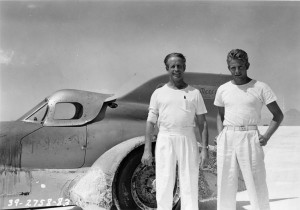 In the Thirties and Forties, a Salt Lake City construction worker turned racecar driver transformed the notion of what a car was capable of, and he transformed the Bonneville Salt Flats from a plain of death into a landscape of possibility.
In the Thirties and Forties, a Salt Lake City construction worker turned racecar driver transformed the notion of what a car was capable of, and he transformed the Bonneville Salt Flats from a plain of death into a landscape of possibility.
For most Americans, Ab Jenkins isn’t exactly a household name, but many of the speed records he set in his handcrafted car, the Mormon Meteor, still hold 70 years after he set them racing across the Utah wasteland.
Salt Lake City director Curt Wallin presents Ab Jenkins’ story in The Boys of Bonneville: Racing on a Ribbon of Salt. Trained as a biologist, Wallin devoted many of his early films to the natural world. A film about fast cars, he says, it s a bit of a departure. But when the car’s current owner approached him about making the film, he says, “I couldn’t resist doing this.”
The Boys of Bonneville has it Colorado premier Saturday, June 11 at 10 a.m. at the Breckenridge Festival of Film. The Festival runs June 9-12.
NEW WEST: I would guess for somebody who is interested in the natural world, the Bonneville Salt Flats is a pretty fascinating place to be working.
CURT WALLIN: It is. It’s amazing. It’s stark. There’s nothing out there, you would think. But if you get out on the edge of the salt, I was finding fossils and arrowheads and all sorts of cool things. Everywhere you go there’s something interesting. And history. The salt flats have so much history. This is an amazing story with a lot of history. I could resist doing this.
Ab Jenkins isn’t exactly a household name for most of us. Should it be?
That’s one reason we did this film. It’s a great American story. You have someone who comes up from, really, almost impoverished rural Utah and brings himself all the way up, up to this level of racing. Most people would look at it as rags to riches. You persevere. You work hard. That’s the American story. That’s what this is all about. And that’s what we sought to portray. Anybody can do something if they set their mind to it, if they have the passion for it.
Back in the 1930s you’re looking at a time period of the toughest economic times. Although, of course, now is tough, too. But you’re looking at guys who had to do things with engineering that you couldn’t imagine today. They didn’t have computers. They had to make it up all on their own.
In some ways the Bonneville Salt Flats seem like a landscape that embodies the myth of the West as a place of dreams and possibilities, a place where anything could happen.
Originally it wasn’t that way. It was a barrier. It’s where the Donner Party got stuck. It’s the reason they got in trouble on Donner Pass. You can go out there now and see the original wagon tracks and pieces of the wagon they had.
It was terrible. It was ugly out there. Back then, nobody wanted to go there. It wasn’t a place of dreams. It was a place of peril. Now it’s flipped. It’s a place where all your ingenuity, everything you put together can come to fruition. How fast can you go? That’s what it’s all about out there. Ab changed all that. He’s the whole reason for that.
Did you know Ab’s story when you began this project?
I did a little bit, because the car was in the capitol when I was a kid. But I had no idea how in-depth the story was.
And some of Ab’s speed records still remain intact?
Yeah. He had so many records. He had the world records for having so many world records. He really did. Twelve records still hold today.
Did you ever get a chance to drive the Mormon Meteor?
No I’ve just sat in it. I wouldn’t dare. That thing is considered one of the most important racecars in the world. One of the most important cars. One of the most expensive cars in the world. I’m a director and camera guy. I don’t drive cars that well.
What was it like to sit in there?
It’s tight. It’s so small. The bigger the steering wheel, the easier it is, the less effort to turn, the more control you have on a circular track. But it’s very uncomfortable because you’re jammed in there with a big steering wheel. You can’t move. And they didn’t have air conditioning. You’re talking 116 degrees back in 1940 when he did all this and broke all the records. Then it gets totally cold at night. You freeze to death at night and bake during the day.
Was this sort of a lost age of American heroes?
You get a lot of American heroes coming out during tough times. That’s when people shine. That’s when you get people coming through. There are a lot of heroes from the 1930s and Forties that we haven’t heard about that should be told. Yeah, it’s a lost time.


